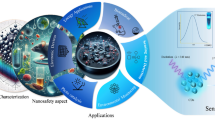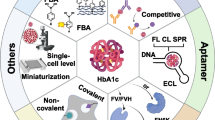Abstract
Here, an efficient in vitro fluorescence biosensor for bovine serum albumin (BSA) based on the aggregation and release of CdS quantum dots (QDs) within carboxymethyl cellulose (CMC) was investigated and discussed. The aggregation of CdS QDs within CMC was prepared by electrostatic interaction. The release of CdS QDs was due to strong covalent linking between BSA and CMC, thus leading to the more favorable combination of BSA and CMC in the system with the presence of BSA. The detection of BSA was based on the quenching and recovery of fluorescence intensity in the system, which was caused by the aggregation and release of CdS QDs. An excellent linear relationship (R2 = 0.99286) was obtained between fluorescence intensity and BSA concentration (0.05–2.00 μM) with a detection limit of 10−8 M. In addition, the detection method showed high selectivity towards BSA and good stability. These results suggest that the method can be utilized as an efficient and highly selective reagent for quantification of BSA for in vitro biological science.









Similar content being viewed by others
References
Achadu OJ, Nyokong T (2017) Graphene quantum dots coordinated to mercaptopyridine-substituted phthalocyanines: characterization and application as fluorescence “turn ON” nanoprobes. Spectrochim Acta Part A 174:339–347
Adegoke O, Morita M, Kato T et al (2017) Localized surface plasmon resonance-mediated fluorescence signals in plasmonic nanoparticle-quantum dot hybrids for ultrasensitive Zika virus RNA detection via hairpin hybridization assays. Biosens Bioelectron 94:513–522
Biswal DR, Singh RP (2004) Characterisation of carboxymethyl cellulose and polyacrylamide graft copolymer. Carbohydr Polym 57:379–387
Carter DC, Ho JX (1994) Structure of serum albumin. Adv Protein Chem 45: 153–176, 176a, 176b, 176c, 176d, 176e, 176f, 176g, 176h, 176i, 176j, 176k, 176l, 177–203
Chee GJ (2016) A novel whole-cell biosensor for the determination of trichloroethylene. Sens Actuators B 23:836–840
Chen SF, Chen XQ, Xia TT et al (2016) A novel electrochemiluminescence sensor for the detection of nitroaniline based on the nitrogen-doped graphene quantum dots. Biosens Bioelectron 85:903–908
Coleman JN, Khan U, Blau WJ et al (2006) Small but strong: a review of the mechanical properties of carbon nanotube-polymer composites. Carbon 44:1624–1652
Cui M, Wang FJ, Shao ZQ et al (2011) Inflfluence of DS of CMC on morphology and performance of magnetic microcapsules. Cellulose 18:1265–1271
Ding SY, Jones M, Tucder MP et al (2003) Quantum dot molecules assembled with genetically engineered proteins. Nano Lett 3:1581–1585
Dong YG, Yang JL, Ding YL et al (2015) Size-controllable synthesis of highly fluorescent carbon quantum dots in a reverse microemusion. Chin J Lumin 36:157–162
Gao XH, Nie SM (2004) Quantum dot-encoded mesoporous beads with high brightness and uniformity: rapid readout using flow cytometry. Anal Chem 76:2406–2410
Gao XH, Cui YY, Levenson RM et al (2004) In vivo cancer targeting and imaging with semiconductor quantum dots. Nat Biotechnol 22:969–976
Gu XM, Chen Q, Fang ZJ (2017) A novel fluorescent probe based on β-C-glycoside for quantification of bovine serum albumin. Dyes Pigments 139:334–343
Guo ZX, Shen HX (1999) A highly sensitive assay for protein using resonance light-scattering technique with dibromohydroxyphenylfluorone–molybdenum(VI) complex. Spectrochim Acta A 55:2919–2925
Guo Y, Zeng XQ, Yuan HY et al (2017) Chiral recognition of phenylglycinol enantiomers based on N-acetyl-l-cysteine capped CdTe quantum dots in the presence of Ag+. Spectrochim Acta Part A 183:23–29
Han D, Yan L, Chen W et al (2011a) Preparation of chitosan/graphene oxide composite film with enhanced mechanical strength in the wet state. Carbohydr Polym 83:653–658
Han DL, Yan LF, Chen WF et al (2011b) Cellulose/graphite oxide composite films with improved mechanical properties over a wide range of temperature. Carbohydr Polym 83:966–972
Jaiseal JK, Mattoussi H et al (2003) Long-term multiple color imaging of live cells using quantum dot bioconjugates. Nat Biotechnol 21:47–51
Jasim A, Ullah MW, Shi ZJ et al (2017) Fabrication of bacterial cellulose/polyaniline/single-walled carbon nanotubes membrane for potential application as biosensor. Carbohydr Polym 163:62–69
Jia MF, Zhang Z, Li JH et al (2017) A molecular imprinting fluorescence sensor based on quantum dots and a mesoporous structure for selective and sensitive detection of 2,4-dichlorophenoxyacetic acid. Sens Actuators B 252:934–943
Junaid M, Imran M, Ikram M et al (2019) The study of Fe-doped CdS nanoparticle-assisted photocatalytic degradation of organic dye in wastewater. Appl Nanosci 9:1593–1602
Li Y, Dong LJ, Wang WP et al (2006) Flow injection analysis–Rayleigh light scattering detection for online determination of protein in human serum sample. Anal Biochem 354:64–69
Li ZS, Xu W, Wang YT et al (2015) Quantum dots loaded nanogels for low cytotoxicity, pH-sensitive fluorescence, cell imaging and drug delivery. Carbohydr Polym 121:477–485
Li GH, Sun KY, Li DW et al (2016) Biosensor based on bacterial cellulose-Au nanoparticles electrode modified with laccase for hydroquinone detection. Colloids Surf A 509:408–414
Liu SP, Yang Z, Liu ZF et al (2006) Resonance Rayleigh-scattering method for the determination of proteins with gold nanoparticle probe. Anal Biochem 353:108–116
Liu LZ, Feng F, Pauu MC et al (2015a) Sensitive determination of kaempferol using carbon dots as a fluorescence probe. Talanta 144:390–397
Liu X, Fu CH, Ren XL et al (2015b) Fluorescence switching method for cascade detection of salicylaldehyde and zinc(II) ion using protein protected gold nanoclusters. Biosens Bioelectron 74:322–328
Liu HY, Dong YS, Zhang BB et al (2016a) An efficient quinoline-based fluorescence sensor for zinc(II) and its application in live-cell imaging. Sens Actuators B 234:616–624
Liu ZZ, Gong Y, Fan ZF (2016b) Cysteine detection using a high-fluorescence sensor based on a nitrogen-doped graphene quantum dot–mercury(II) system. J Lumin 175:129–134
Liu RJ, Zhao JJ, Huang ZR et al (2017a) Nitrogen and phosphorus co-doped graphene quantum dots as a nano-sensor for highly sensitive and selective imaging detection of nitrite in live cell. Sens Actuators B 240:604–612
Liu ZM, Zhang X, Cui L et al (2017b) Development of a highly sensitive electrochemiluminescence sophoridine sensor using Ru(bpy) 2+3 integrated carbon quantum dots–polyvinyl alcohol composite film. Sens Actuators B 248:402–410
Lu ZS, Chen XJ, Hu WH (2017) A fluorescence aptasensor based on semiconductor quantum dots and MoS2 nanosheets for ochratoxin A detection. Sens Actuators B 246:61–67
Mansur AAP, de Carvalho FG, Mansru RL et al (2017) Carboxymethylcellulose/ZnCdS fluorescent quantum dot nanoconjugates for cancer cell bioimaging. Int J Biol Macromol 96:675–686
Mao J, Yao JN, Wang LN (2008) Easily prepared high-quantum-yield CdS quantum dots in water using hyperbranched polyethylenimine as modifier. J Colloid Interface Sci 319(1):353–356
Mehrzad-Samarin M, Faridbod F, Dezfuli AS et al (2017) A novel metronidazole fluorescent nanosensor based on graphene quantum dots embedded silica molecularly imprinted polymer. Biosens Bioelectron 92:618–623
Ngamdee K, Kulchat S, Tuntulani T et al (2017) Fluorescence sensor based on d-penicillamine capped cadmium sulfide quantum dots for the detection of cysteamine. J Lumin 187:260–268
Ni Y, Zhang F, Kokot S (2013) Graphene oxide as a nanocarrier for loading and delivery of medicinal drugs and as a biosensor for detection of serum albumin. Anal Chim Acta 769:40–48
Nicholson JP, Wolmarans MR (2000) The role of albumin in critical illness. Br J Anaesth 85:599–610
Nie H, Liu M, Zhan F et al (2004) Factors on the preparation of carboxymethylcellulose hydrogel and its degradation behavior in soil. Carbohydr Polym 58:185–189
Phukn P, Radhapyari C, Konwar BK et al (2014) Natural polyhydroxyalkanoate–gold nanocomposite based biosensor for detection of antimalarial drug artemisinin. Mater Sci Eng C 37:314–320
Ratnesh RK, Mehata MS (2017) Investigation of biocompatible and protein sensitive highly luminescent quantum dots/nanocrystals of CdSe, CdSe/ZnS and CdSe/CdS. Acta Part A 179:201–210
Refat MS, Al-Maydama HMA, Al-Azab FM et al (2014) Synthesis, thermal and spectroscopic behaviors of metal–drug complexes: La(III), Ce(III), Sm(III) and Y(III) amoxicillin trihydrate antibiotic drug complexes. Spectrochim Acta Part A 128:427–446
Robelek R, Niu LF, Schmid EL et al (2004) Multiplexed hybridization detection of quantum dot-conjugated DNA sequences using surface plasmon enhanced fluorescence microscopy and spectrometry. Anal Chem 76:6160–6165
Sasmal M, Maiti TK, Bhattacharyya TK (2015) Synthesis of ZnO nanosphere for picomolar level detection of bovine serum albumin. IEEE Trans Nanobiosci 14(1):129–137
Selvaprakash K, Chen YC (2014) Using protein-encapsulated gold nanoclusters as photoluminescent sensing probes for biomolecules. Biosens Bioelectron 61:88–94
Tang AM, Liu Y, Wang QW et al (2016) A new photoelectric ink based on nanocellulose/CdS quantum dots for screen-printing. Carbohydr Polym 148:29–35
Wang DY, Rogach AL, Caruso F (2002) Semiconductor quantum dot-labeled microsphere bioconjugates prepared by stepwise self-assembly. Nano Lett 2:857–861
Wang L, Wang J, Chen Y et al (2011) One-step synthesis and quantum yield of CdS quantum dots. Chem J Chin U 32:1043–1048
Wang K, Dong YH, Li BY et al (2017) Differentiation of proteins and cancer cells using metal oxide and metal nanoparticles-quantum dots sensor array. Sens Actuators B 250:69–75
Weng H, Yan B (2016) A flexible Tb(III) functionalized cadmium metal organic framework as fluorescent probe for highly selectively sensing ions and organic small molecules. Sens Actuators B 228:702–708
Yadav M, Rhee KY, Jung IH (2013) Eco-friendly synthesis, characterization and properties of a sodium carboxymethyl cellulose/graphene oxide nanocomposite film. Cellulose 20:687–698
Yan YJ, He XW, Li WY et al (2017) Nitrogen-doped graphene quantum dots-labeled epitope imprinted polymer with double templates via the metal chelation for specific recognition of cytochrome c. Biosens Bioelectron 91:253–261
Yang CL, Deng WP, Liu HY et al (2015) Turn-on fluorescence sensor for glutathione in aqueous solutions using carbon dots–MnO2 nanocomposites. Sens Actuators 216:286–292
Yang HY, Fu Y, Jang MS et al (2017) CdSe@ZnS/ZnS quantum dots loaded in polymeric micelles as a pH-triggerable targeting fluorescence imaging probe for detecting cerebral ischemic area. Colloids Surf B 155:497–506
Yu WW, Chang E, Drezek R et al (2006) Water-soluble quantum dots for biomedical applications. Biochem Biophys Res Commun 348:781–786
Yu XF, Chen LD, Li KY et al (2007) Immunofluorescence detection with quantum dot bioconjugates for hepatoma in vivo. J Biomed Opt 12:014008
Zhang HC, Shang YY, Zhang T et al (2017a) Engineering graphene/quantum dot interfaces for high performance electrochemical nanocomposites in detecting puerarin. Sens Actuators B 242:492–501
Zhang N, Zhang L, Ruan Y et al (2017b) Quantum-dots-based photoelectrochemical bioanalysis highlighted with recent examples. Biosens Bioelectron 94:207–218
Zhu W, Xuan C, Liu G et al (2015a) A label-free fluorescent biosensor for determination of bovine serum albumin and calf thy mus DNA based on gold nanorods coated with acridine orange-loaded mesoporous silica. Sens Actuators B 220:302–308
Zhu J, Liu XQ, Wang XH et al (2015b) Preparation of polyaniline–TiO2 nanotube composite for the development of electrochemical biosensors. Sens Actuators B 221:450–457
Acknowledgments
This work is supported by the Changbai Mountain Scholars’ Special Fund (No. 2015047).
Author information
Authors and Affiliations
Corresponding author
Additional information
Publisher's Note
Springer Nature remains neutral with regard to jurisdictional claims in published maps and institutional affiliations.
Rights and permissions
About this article
Cite this article
Cui, M., Xin, Y., Song, R. et al. Fluorescence sensor for bovine serum albumin detection based on the aggregation and release of CdS QDs within CMC. Cellulose 27, 1621–1633 (2020). https://doi.org/10.1007/s10570-019-02865-4
Received:
Accepted:
Published:
Issue Date:
DOI: https://doi.org/10.1007/s10570-019-02865-4




